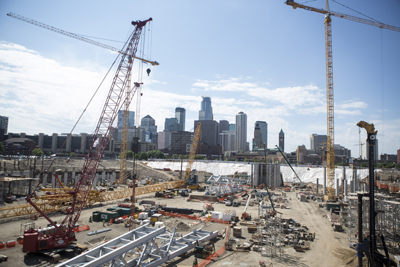May construction employment, April spending hit 6-year highs; most metros add jobs
 Editor’s note: Construction Citizen is proud to partner with AGC America to bring you AGC Chief Economist Ken Simonson's Data DIGest. Check back each week to get Ken's expert analysis of what's happening in our industry.
Editor’s note: Construction Citizen is proud to partner with AGC America to bring you AGC Chief Economist Ken Simonson's Data DIGest. Check back each week to get Ken's expert analysis of what's happening in our industry.
Nonfarm payroll employment increased by 280,000 in May, seasonally adjusted, and by 3,058,000 (2.2%) over 12 months, the Bureau of Labor Statistics (BLS) reported on Friday. Construction employment rose by 17,000 and 273,000 (4.5%), respectively, to 6,387,000, the highest level since February 2009. Residential construction employment (residential building and specialty trade contractors) climbed by 8,500 for the month and 149,000 (6.5%) over 12 months. Nonresidential employment (building, specialty trades, and heavy and civil engineering construction) increased by 8,600 and 124,300 (3.3%), respectively. Average hourly earnings of all employees in construction rose to $27.34, a gain of 2.7% over the past year, up from 2.3% in the previous 12 months and 1.3% from May 2012 to May 2013. The steepest wage increases among construction segments (which are reported with a one-month lag) occurred in residential building (4.8% from April 2014 to April 2015) and heavy and civil engineering construction (5.1%), while hourly earnings rose 3.3% in nonresidential building and 1.6% in specialty trades (residential and nonresidential combined). The number of unemployed jobseekers who last worked in construction fell from 747,000 in May 2014 to 569,000 in May 2015, the lowest May total since 2005. The unemployment rate for such workers fell from 8.6% to 6.7%, the lowest May rate since 2006. (Industry unemployment data are not seasonally adjusted and should only be compared year-over-year, not across months.) The acceleration in wages and decline in the pool of experienced jobseekers suggests that contractors soon may have even greater difficulty finding qualified new hires.
Construction spending in April totaled $1.006 trillion at a seasonally adjusted annual rate, up 2.2% from the upwardly revised rate in March, up 4.8% from April 2014, and the highest rate since November 2008, the Census Bureau reported on Wednesday. Because unseasonably mild or severe weather can distort monthly comparisons in winter, it is more revealing to compare year-to-date figures for January through April combined. On that basis, total spending increased 4.1% from the same months of 2014, private nonresidential spending increased 8.7%, public construction spending gained 3.1% and private residential spending inched up 0.3%. However, the residential total masks a 13% rise in new construction (27% for multifamily and 10% for single-family) and a drop of 34% in improvements. Although improvements are included in totals, Census does not consider the estimate reliable enough to publish. It seems improbable that improvements would have fallen, let alone so steeply, when there were year-to-date increases in new-home sales (24%, Census reported on May 26) and existing-home sales (6%, according to National Association of Realtors reports). The largest private nonresidential segment, power construction (conventional and renewable power plus oil and gas fields and pipelines), plunged 15% year-to-date. This figure also hides a huge difference: between electric power, down 42%, and other (mainly pipelines), up 47%. The next largest private segments (in descending order of current size) were manufacturing construction, which soared 43%; commercial (new and renovated retail, warehouse and farm), up 17%, driven by a 42% jump in warehouse construction; and office, up 22%. The two top public segments eked out year-to-date gains: highway and street construction, 0.4%; and public educational spending, 1.0%.
Construction employment, not seasonally adjusted, increased from April 2014 to April 2015 in 232 (65%) of the 358 metro areas (including divisions of larger metros) for which the BLS provides construction employment data, decreased in 66 (18%) and was stagnant in 60, according to an AGC release and map on Tuesday that analyzed BLS data. (BLS combines mining and logging with construction in most metros to avoid disclosing data about industries with few employers.) The Seattle-Bellevue-Everett division again added the largest number of construction jobs in the past year (12,600 construction jobs, 17%), followed by Denver-Aurora-Lakewood (10,800 combined jobs, 12%). The largest percentage gains again occurred in Wenatchee, Wash. (32%, 600 combined jobs), followed by Atlantic City-Hammonton, N.J. (24%, 1,100 combined jobs). The largest job losses again were in New Orleans-Metairie (-3,300 construction jobs, -10%) and Gulfport-Biloxi-Pascagoula, Miss. (-1,800 combined jobs, -18%). The largest percentage decline was in Weirton-Steubenville, W.Va.-Ohio (-29%, -600).
"Reports from the 12 Federal Reserve districts suggest overall economic activity expanded during the reporting period from early April to late May," the Fed reported on Wednesday in its latest "Beige Book," a compilation of informal soundings of business conditions in the districts (which are referenced by the name of their headquarters cities). "Manufacturers of construction materials and/or machinery continued to see strengthening demand in the Cleveland and Chicago districts, but unusually wet weather caused demand to flatten in the Dallas district....Residential activity increased slightly in the Chicago district, where contacts expressed concern that the current strong pace of apartment construction was unsustainable....Strength in multifamily construction was reported in the Cleveland, Atlanta and San Francisco districts, and the Richmond district continued to experience steady apartment building activity....Contacts in the St. Louis district noted...continued commercial and industrial construction. Commercial building increased in the Chicago district, driven by demand for industrial and office space, and new hotel and office development in downtown Chicago was compelling retailers to relocate. The Cleveland and Atlanta districts noted increased construction backlogs, and shortages of skilled labor remained a constraint on construction activity in some districts, such as Boston, Cleveland and San Francisco....A tight market for skilled construction labor in the Boston, Dallas and San Francisco districts pushed up wages for workers there."
The Data DIGest is a weekly summary of economic news; items most relevant to construction are in italics. All rights reserved. Sign up at www.agc.org/datadigest.


